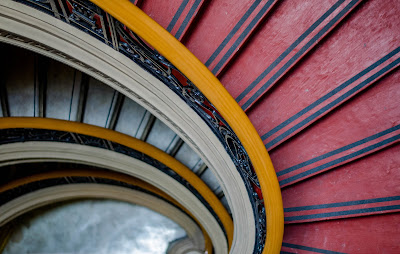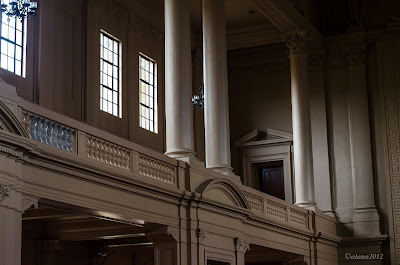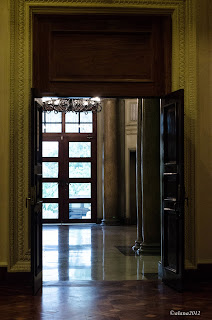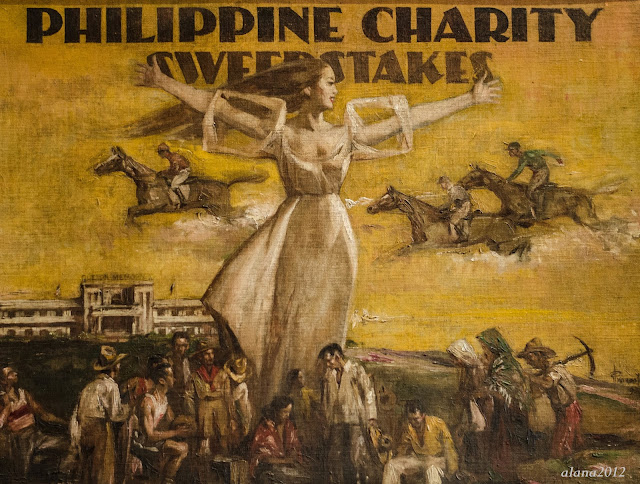 |
In these building the unbroken record of what makes us Filipino can be found as well. From our earliest artifacts in clay, to our artistic treasures on canvas, and this room itself, are concrete reminders of what Rizal said, “Ang hindi marunong lumingon sa pinanggalinan ay hindi makararating sa paroroonan.”
- President Benigno "Noynoy" Aquino
Old buildings are charming, but not when they are in a sorry state. Old should not necessarily mean ignored and abandoned specially if we are talking of buildings and halls that were the venue of debates and legislatures that shaped our country. It was a Sunday when I visited the newly restored Senate session hall. Fortunately, there were not too many visitors then and it was a week before President Noynoy would actually see it for himself. I went ahead of him.
I must say I am pretty impressed with the facelift; not that it would surpass those old charms of Europe but it will definitely bring you back to years before your time. The hall was designed in 1918 by American Architect Daniel Burnham but layout changes were done in 1926 by a Filipino Architect Juan M. Arellano. The Old legislative building was heavily damaged during the American liberation in 1945 reducing it to ruins but by some miracle only the Senate Session Hall remained intact. Somehow, i feel it to be a sure sign that history wants us to look at our past, perhaps cliche-ic, to foresee our future.
In this same hall the last American Governor-General Frank Murphy gave his final address before the Philippine Commonwealth was inaugurated. President Manuel Quezon took his oath as President here in 1935. Since then, one can only imagine the debates and discussions those walls have witnessed from the country's great statesmen. I could almost hear Senator Claro M. Recto fiercely defending the Rizal bill against the attacks of the Catholic clergies. Likewise, the same hall and walls were there when Senator Benigno “Ninoy” Aquino Jr. and his allies in the opposition delivered privilege speeches during the run-up to martial law in 1972.
The Old Hall continued to serve the Senate until the declaration of Martial Law in 1972 and once again after the restoration of democracy from 1987 to 1996 when the Senate transferred to the GSIS Bldg. in Pasay City. The National Museum thereafter with its mandate, was tasked to preserve the Old Senate Hall as a tribute to the legacy of great statesmen of the country and as a relic where democracy and freedom reigned.
 |
| Old Senate Hall circa 26 Photo from the Official Gazette of the Philippines |
Speech of President Aquino at the 111th anniversary of the National Museum, October 29, 2012
[Delivered at the Old Legislative Building, National Museum, Manila, on October 29, 2012]
President Fidel Valdez Ramos; Secretary Armin Luistro; Secretary Mon Jimenez; Mayor Alfedo Lim; Mr. Ramon del Rosario, chairman of the board of trustees of the National Museum; Mr. Jeremy Barns, Director of the National Museum; Ms. Maribel Ongpin; Chairman Daniel Lacson of the GSIS; President Robert Vergara of the GSIS; Board of Trustees of the GSIS; officers and staff of the National Museum; fellow workers in government; honored guests; mga minamahal ko pong kababayan:
Magandang hapon po sa inyong lahat.
The continuing challenge of history weighs heavily on this place. In this building, the 1935 Constitution was written. Its guarantees of rights and freedoms, as my father reminded us in 1983, represented “the most sacred legacies from the founding fathers.” Three of my predecessors were inaugurated on these grounds, marking three chapters in our development as a nation: from the Commonwealth, to the Second Republic, and then until the transition to the Third Republic. In this old Senate Hall, my grandfather served as Speaker of the wartime National Assembly, when our people faced great hardship in the hands of foreign oppressors. It was also here that my father, as a senator, stood his ground and spoke up against strongman rule. And it was here that the Senate, an institution I have belonged to, reconvened when Congress was restored in 1987.
 |
| Stairs. Old Legislative Building |
In these building the unbroken record of what makes us Filipino can be found as well. From our earliest artifacts in clay, to our artistic treasures on canvas, and this room itself, are concrete reminders of what Rizal said, “Ang hindi marunong lumingon sa pinanggalinan ay hindi makararating sa paroroonan.”
I take great pride in coming here as your President to pay homage to all those who have sacrificed to win and protect our right to exist as a free people. It is fitting, therefore, that we unveil the marker of our Old Senate Hall today—a reminder that the enduring flame of history, and the many shining examples of the genius of our countrymen, serve as a guide to one united Filipino nation that moves on the straight path to progress. I am also here to remind all our countrymen that when we praise Rizal, Bonifacio, and our other heroes, we do so not because the best is already behind us. We do so, because they challenge us to build a better future. In this effort, culture and the arts are vital to our national advancement.
 After all, nothing less than our Constitution commands us to view culture and the arts, our history and natural resources, and those of you who have dedicated your lives to its study, protection, dissemination, and development, as national priorities and responsibilities. Our Constitution views culture and the arts not as a luxury, but as a necessity if we are to have a vibrant national life. It is through education, research, and the arts that we can achieve “total human liberation and development” as a democratic society.
After all, nothing less than our Constitution commands us to view culture and the arts, our history and natural resources, and those of you who have dedicated your lives to its study, protection, dissemination, and development, as national priorities and responsibilities. Our Constitution views culture and the arts not as a luxury, but as a necessity if we are to have a vibrant national life. It is through education, research, and the arts that we can achieve “total human liberation and development” as a democratic society.
Our people deserve better than to have our national heritage treated as an afterthought. Art and culture must be treated as part of a strategy for increasing national competitiveness.
Our plan is straightforward and has three parts.
 |
| Lights off |
First, to concentrate our efforts on our core competencies. I am happy to see government institutions working together to achieve efficiency, enabling each other to focus on their core mandates. The decision of the GSIS to entrust its collection of art to the National Museum is an example of this. It gives our people the opportunity to enjoy the marvels of our various heritages, while allowing the GSIS to focus more on its task.
Second, we are giving you the means to do your jobs. The budget increases we have given to our centers of heritage are significant. For the National Archives, from 76 million pesos in 2011, we raised their annual budget to 85 million pesos. For the National Library, we increased their budget by 47 million for 2012, totaling to almost 138 million pesos, which thus helps our lead institutions protect the many national documents they maintain for the benefit of later generations. To ascertain the conservation and protection of our historical sites, and to advance scholarship, we gave an almost 100 percent increase to the budget of the National Historical Institute, bringing it to 174 million pesos for this year. For our National Museum, we allocated 238 million pesos for 2012, which is 95 million pesos higher than your budget for 2011. And for 2013, we intend to give you 556 million pesos, so that you may carry out the necessary restorations for our historical and cultural collections. [Applause]
 Our institutions must likewise have durable and permanent homes, for you to become effective in fulfilling your mandate to safeguard our nation’s cultural treasures. We are retrofitting the National Library and studying the transfer of the National Archives to the Intendencia in Intramuros, which will allow them to better address the needs of scholars. Now we are gradually implementing the National Museum Plan of 1998, which will finally pave the way for the establishment of our National Museum of Natural History, not just as a showcase for the richness of our natural resources and biodiversity, but as a place of research and education to help build a more scientifically literate society. For this, we have allocated 500 million pesos, which will cover the necessary construction expenses of the museum.
Our institutions must likewise have durable and permanent homes, for you to become effective in fulfilling your mandate to safeguard our nation’s cultural treasures. We are retrofitting the National Library and studying the transfer of the National Archives to the Intendencia in Intramuros, which will allow them to better address the needs of scholars. Now we are gradually implementing the National Museum Plan of 1998, which will finally pave the way for the establishment of our National Museum of Natural History, not just as a showcase for the richness of our natural resources and biodiversity, but as a place of research and education to help build a more scientifically literate society. For this, we have allocated 500 million pesos, which will cover the necessary construction expenses of the museum. The third part of our plan is to empower institutions to work with our people and with each other. With the help of groups like the Philippine National Museum Foundation, which through the years has shown great support to the National Museum, we are working hand in hand to preserve our cultural artifacts and to advance the understanding and appreciation of our people for these. I understand that discussions are taking place between members of my Cabinet such as Ricky Carandang, Mon Jimenez, Butch Abad, and Cesar Purisima, and various stakeholders in our cultural community, so that your concerns can be raised. You will find all of us willing to listen and eager to help. On the other hand, you are all called to public service, and this means being part of the solution, and not part of the problem. Please use your budgets well, and responsibly: do not shortchange the public just so you can give bonuses to yourselves. We will take care of your bonuses. As government institutions, it is only fair to expect you to discard old habits the same way other agencies are discarding the old status quo.
The third part of our plan is to empower institutions to work with our people and with each other. With the help of groups like the Philippine National Museum Foundation, which through the years has shown great support to the National Museum, we are working hand in hand to preserve our cultural artifacts and to advance the understanding and appreciation of our people for these. I understand that discussions are taking place between members of my Cabinet such as Ricky Carandang, Mon Jimenez, Butch Abad, and Cesar Purisima, and various stakeholders in our cultural community, so that your concerns can be raised. You will find all of us willing to listen and eager to help. On the other hand, you are all called to public service, and this means being part of the solution, and not part of the problem. Please use your budgets well, and responsibly: do not shortchange the public just so you can give bonuses to yourselves. We will take care of your bonuses. As government institutions, it is only fair to expect you to discard old habits the same way other agencies are discarding the old status quo. Now, the fulfillment of our dream of our museums and libraries rivaling those in foreign lands can be seen on the horizon. But for our vision to be fully realized, we must work harder as far as the broader public, at home and abroad, are concerned. Our National Tourism Development Plan identifies the promotion of our culture as central in pursuing our national tourism agenda. We are optimistic that, through this, more Filipinos and foreigners will be enticed to tour our country. We know that the development of our cultural program is fundamental in achieving our tourism growth target of ten million international visitors and 35.5 million domestic tourists by 2016. Let us therefore embrace our countrymen, and always bear in mind that our cultural institutions cannot be independent of our people or their values, or worse, dismissive either of public opinion or the public itself, Filipino or foreign.
Now, the fulfillment of our dream of our museums and libraries rivaling those in foreign lands can be seen on the horizon. But for our vision to be fully realized, we must work harder as far as the broader public, at home and abroad, are concerned. Our National Tourism Development Plan identifies the promotion of our culture as central in pursuing our national tourism agenda. We are optimistic that, through this, more Filipinos and foreigners will be enticed to tour our country. We know that the development of our cultural program is fundamental in achieving our tourism growth target of ten million international visitors and 35.5 million domestic tourists by 2016. Let us therefore embrace our countrymen, and always bear in mind that our cultural institutions cannot be independent of our people or their values, or worse, dismissive either of public opinion or the public itself, Filipino or foreign. You have probably heard me say time and again: Talagang ang sarap namang maging Pilipino sa panahon ngayon. So much more can be achieved if we are a unified people. You now have the means to join hands with our countrymen to give them a chance to understand and appreciate our history and our society, and to inspire creativity and innovation in all areas of national life. I am confident that together, all our cultural institutions will become become part of the pulse of a nation of hardworking, determined, principled, and free Filipinos.
You have probably heard me say time and again: Talagang ang sarap namang maging Pilipino sa panahon ngayon. So much more can be achieved if we are a unified people. You now have the means to join hands with our countrymen to give them a chance to understand and appreciate our history and our society, and to inspire creativity and innovation in all areas of national life. I am confident that together, all our cultural institutions will become become part of the pulse of a nation of hardworking, determined, principled, and free Filipinos.
I congratulate the National Museum on your 111th anniversary.
Thank you and good day to one and all.






















































